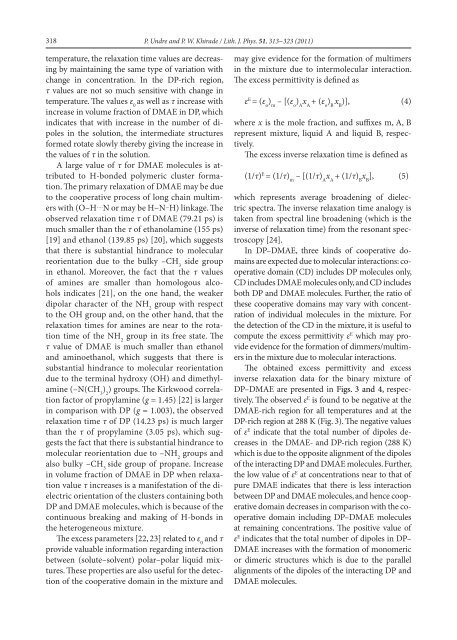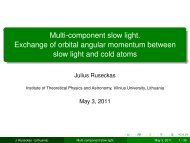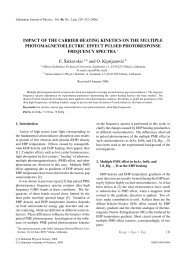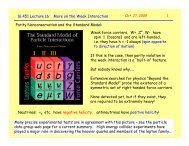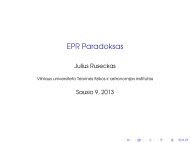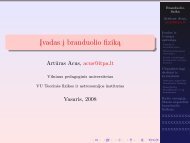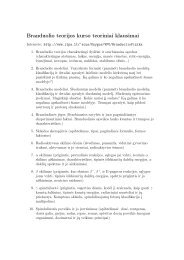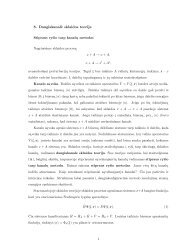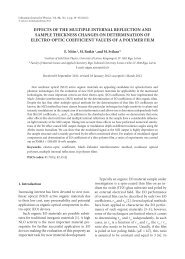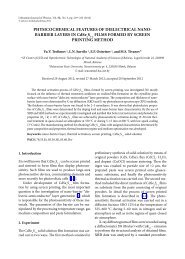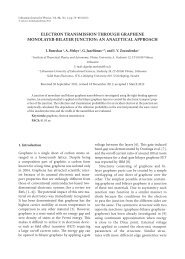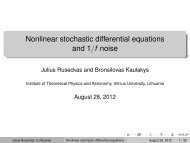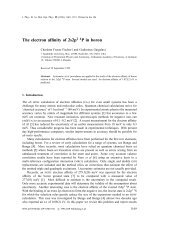DIELECTRIC DISPERSION IN 1,2-DIAMINOPROPANE ...
DIELECTRIC DISPERSION IN 1,2-DIAMINOPROPANE ...
DIELECTRIC DISPERSION IN 1,2-DIAMINOPROPANE ...
You also want an ePaper? Increase the reach of your titles
YUMPU automatically turns print PDFs into web optimized ePapers that Google loves.
318<br />
P. Undre and P. W. Khirade / Lith. J. Phys. 51, 313–323 (2011)<br />
temperature, the relaxation time values are decreasing<br />
by maintaining the same type of variation with<br />
change in concentration. In the DP-rich region,<br />
τ values are not so much sensitive with change in<br />
temperature. The values ε 0<br />
as well as τ increase with<br />
increase in volume fraction of DMAE in DP, which<br />
indicates that with increase in the number of dipoles<br />
in the solution, the intermediate structures<br />
formed rotate slowly thereby giving the increase in<br />
the values of τ in the solution.<br />
A large value of τ for DMAE molecules is attributed<br />
to H-bonded polymeric cluster formation.<br />
The primary relaxation of DMAE may be due<br />
to the cooperative process of long chain multimers<br />
with (O–H …. N or may be H–N ... H) linkage. The<br />
observed relaxation time τ of DMAE (79.21 ps) is<br />
much smaller than the τ of ethanolamine (155 ps)<br />
[19] and ethanol (139.85 ps) [20], which suggests<br />
that there is substantial hindrance to molecular<br />
reorientation due to the bulky –CH 3<br />
side group<br />
in ethanol. Moreover, the fact that the τ values<br />
of amines are smaller than homologous alcohols<br />
indicates [21], on the one hand, the weaker<br />
dipolar character of the NH 2<br />
group with respect<br />
to the OH group and, on the other hand, that the<br />
relaxation times for amines are near to the rotation<br />
time of the NH 2<br />
group in its free state. The<br />
τ value of DMAE is much smaller than ethanol<br />
and aminoethanol, which suggests that there is<br />
substantial hindrance to molecular reorientation<br />
due to the terminal hydroxy (OH) and dimethylamine<br />
(–N(CH 3<br />
) 2<br />
) groups. The Kirkwood correlation<br />
factor of propylamine (g = 1.45) [22] is larger<br />
in comparison with DP (g = 1.003), the observed<br />
relaxation time τ of DP (14.23 ps) is much larger<br />
than the τ of propylamine (3.05 ps), which suggests<br />
the fact that there is substantial hindrance to<br />
molecular reorientation due to –NH 2<br />
groups and<br />
also bulky –CH 3<br />
side group of propane. Increase<br />
in volume fraction of DMAE in DP when relaxation<br />
value τ increases is a manifestation of the dielectric<br />
orientation of the clusters containing both<br />
DP and DMAE molecules, which is because of the<br />
continuous breaking and making of H-bonds in<br />
the heterogeneous mixture.<br />
The excess parameters [22, 23] related to ε 0<br />
and τ<br />
provide valuable information regarding interaction<br />
between (solute–solvent) polar–polar liquid mixtures.<br />
These properties are also useful for the detection<br />
of the cooperative domain in the mixture and<br />
may give evidence for the formation of multimers<br />
in the mixture due to intermolecular interaction.<br />
The excess permittivity is defined as<br />
ε E = (ε o<br />
) m<br />
– [(ε o<br />
) A<br />
x A<br />
+ (ε o<br />
) B<br />
x B<br />
)], (4)<br />
where x is the mole fraction, and suffixes m, A, B<br />
represent mixture, liquid A and liquid B, respectively.<br />
The excess inverse relaxation time is defined as<br />
(1/τ) E = (1/τ) m<br />
– [(1/τ) A<br />
x A<br />
+ (1/τ) B<br />
x B<br />
], (5)<br />
which represents average broadening of dielectric<br />
spectra. The inverse relaxation time analogy is<br />
taken from spectral line broadening (which is the<br />
inverse of relaxation time) from the resonant spectroscopy<br />
[24].<br />
In DP–DMAE, three kinds of cooperative domains<br />
are expected due to molecular interactions: cooperative<br />
domain (CD) includes DP molecules only,<br />
CD includes DMAE molecules only, and CD includes<br />
both DP and DMAE molecules. Further, the ratio of<br />
these cooperative domains may vary with concentration<br />
of individual molecules in the mixture. For<br />
the detection of the CD in the mixture, it is useful to<br />
compute the excess permittivity ε E which may provide<br />
evidence for the formation of dimmers/multimers<br />
in the mixture due to molecular interactions.<br />
The obtained excess permittivity and excess<br />
inverse relaxation data for the binary mixture of<br />
DP–DMAE are presented in Figs. 3 and 4, respectively.<br />
The observed ε E is found to be negative at the<br />
DMAE-rich region for all temperatures and at the<br />
DP-rich region at 288 K (Fig. 3). The negative values<br />
of ε E indicate that the total number of dipoles decreases<br />
in the DMAE- and DP-rich region (288 K)<br />
which is due to the opposite alignment of the dipoles<br />
of the interacting DP and DMAE molecules. Further,<br />
the low value of ε E at concentrations near to that of<br />
pure DMAE indicates that there is less interaction<br />
between DP and DMAE molecules, and hence cooperative<br />
domain decreases in comparison with the cooperative<br />
domain including DP–DMAE molecules<br />
at remaining concentrations. The positive value of<br />
ε E indicates that the total number of dipoles in DP–<br />
DMAE increases with the formation of monomeric<br />
or dimeric structures which is due to the parallel<br />
alignments of the dipoles of the interacting DP and<br />
DMAE molecules.


